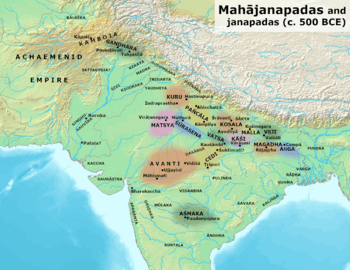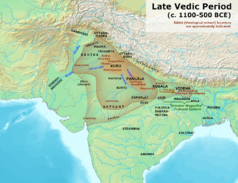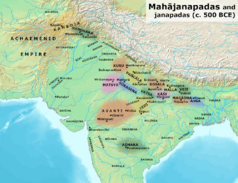Matsya (tribe) facts for kids
Quick facts for kids
Kingdom of Matsya
Macchā
|
|||||||||
|---|---|---|---|---|---|---|---|---|---|
| c. 1400 BCE–c. 350 BCE | |||||||||

Matsya Kingdom and other Mahajanapadas in the Post Vedic period.
|
|||||||||
| Capital | Virāṭanagara | ||||||||
| Common languages | Prakrits | ||||||||
| Religion | Historical Vedic religion | ||||||||
| Demonym(s) | Mātsyeya | ||||||||
| Government | Monarchy | ||||||||
| Raja | |||||||||
| Historical era | Iron Age | ||||||||
|
• Established
|
c. 1400 BCE | ||||||||
|
• Disestablished
|
c. 350 BCE | ||||||||
|
|||||||||
| Today part of | India | ||||||||
The Matsya Kingdom was an ancient kingdom in central South Asia. It was home to the Matsya tribe, an Indo-Aryan group. This kingdom existed during the Iron Age, a time when people started using iron tools. The people of the Matsya tribe were known as the Mātsyeyas.
Contents
What Does Matsya Mean?
The word Macchā in Pāli and Matsya in Sanskrit both mean "fish". This is how the kingdom got its name.
Where Was the Matsya Kingdom?
The Matsya Kingdom covered a large area. Its western border was the Sarasvatī River and nearby forests. To the south were hills near the Chambal River.
Most of the kingdom was in what is now North-eastern Rajasthan, a state in India. Its neighbors were the Kuru to the north and Sūrasena to the east.
The capital city of Matsya was Virāṭanagara. Today, this place is known as Bairāṭ in the Jaipur district of Rajasthan.
History of the Matsya Kingdom
The Matsya tribe was first mentioned in the Ṛgveda, an ancient Indian collection of hymns. They were known for being opponents of King Sudās in a famous battle called the Battle of the Ten Kings.
Ancient texts tell us more about Matsya. The Śatapatha Brāhmaṇa mentions a Matsya king named Dhvasan Dvaitavana. He performed a special horse sacrifice called an aśvamedha near the Sarasvatī River. A forest and a lake were even named after him.
Other old texts, like the Gopatha Brāhmaṇa, mention the Matsyeyas alongside the Śālva tribe. The Kauśītaki Upaniṣad connects them with the Kuru-Pañcāla people.
Later texts, such as the Mahābhārata, link the Matsyeyas with the Trigartas and the Caidyas. The Manu-Saṃhitā lists the Matsyeyas' land as part of Brahmarṣi-deśa. This was considered a holy area for brāhmaṇa sages.
The later history of Matsya is not fully known. However, the Buddhist text Aṅguttara Nikāya listed Matsya as one of the sixteen Mahājanapadas. These were the most powerful states in South Asia just before the birth of the Buddha.
During the Mahājanapada period, Matsya was linked to the Northern Black Polished Ware culture. This was an archaeological culture found in the western Gaṅgā-Yamunā Doab region. It followed the earlier Painted Grey Ware culture.
Unlike some other states that changed their government, Matsya kept its monarchical system. This means it continued to be ruled by a king. Eventually, the Matsya Kingdom was conquered by the powerful empire of Magadha.
The region where Matsya once stood roughly matches the Mewat region of today. This area was later ruled by the Khanzada Rajputs.
Legacy of Matsya
After India gained independence in 1947, some princely states were temporarily grouped together. These included Bharatpur, Dholpur, Alwar, and Karauli.
From 1947 to 1949, they formed the "United States of Matsya". In March 1949, these states joined the modern state of Rajasthan.
Today, the Matsya Festival is held every year in Alwar. It takes place in the last week of November. This festival celebrates the rich culture and adventurous spirit of the region.
See also
- Vedic period
- Janpadas
- Mahajanapadas
- Cemetery H culture
- Painted Grey Ware culture
- Northern Black Polished Ware
- Kingdoms of Ancient India
Sources




